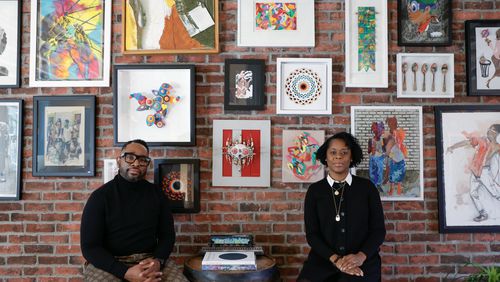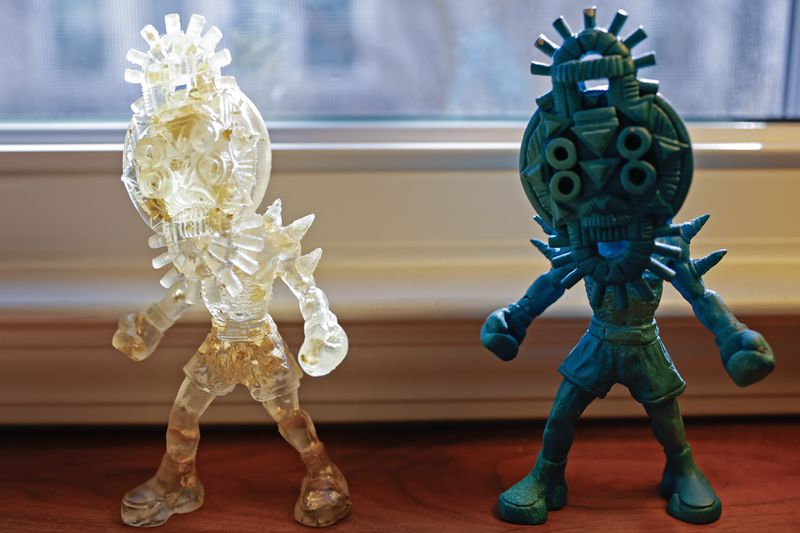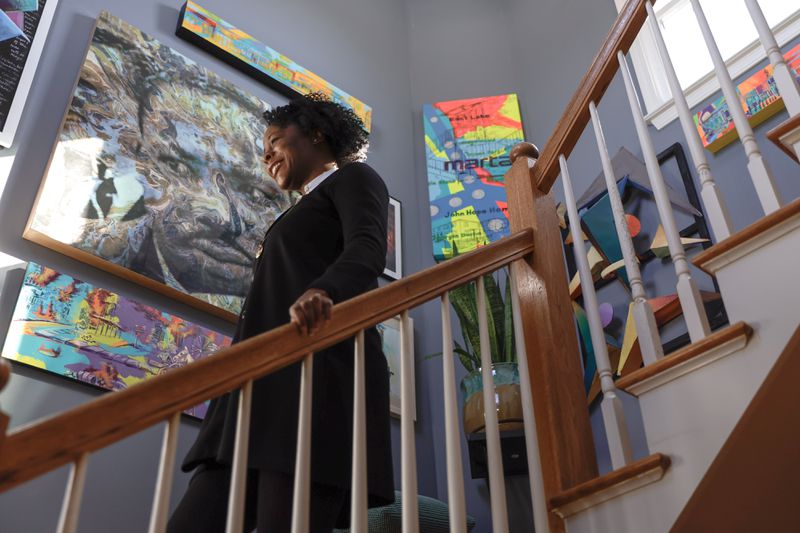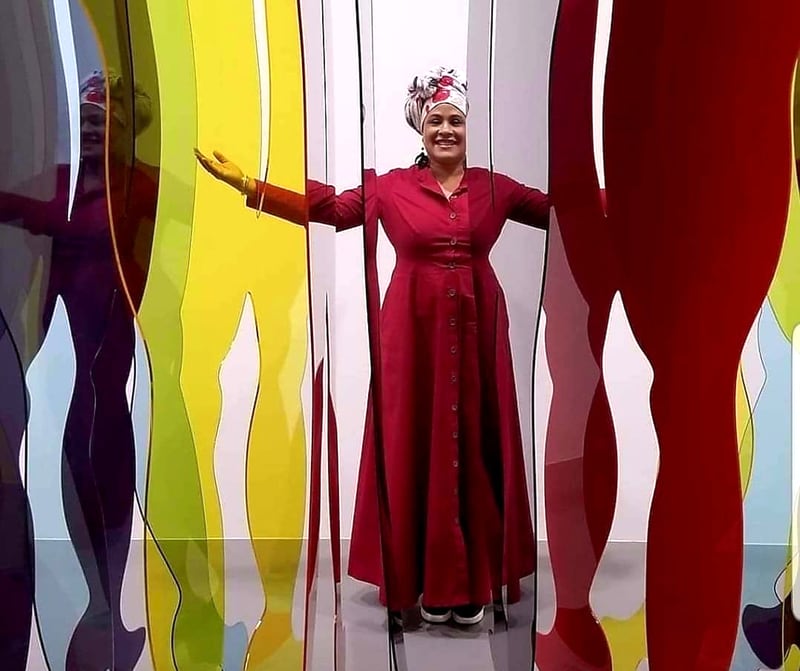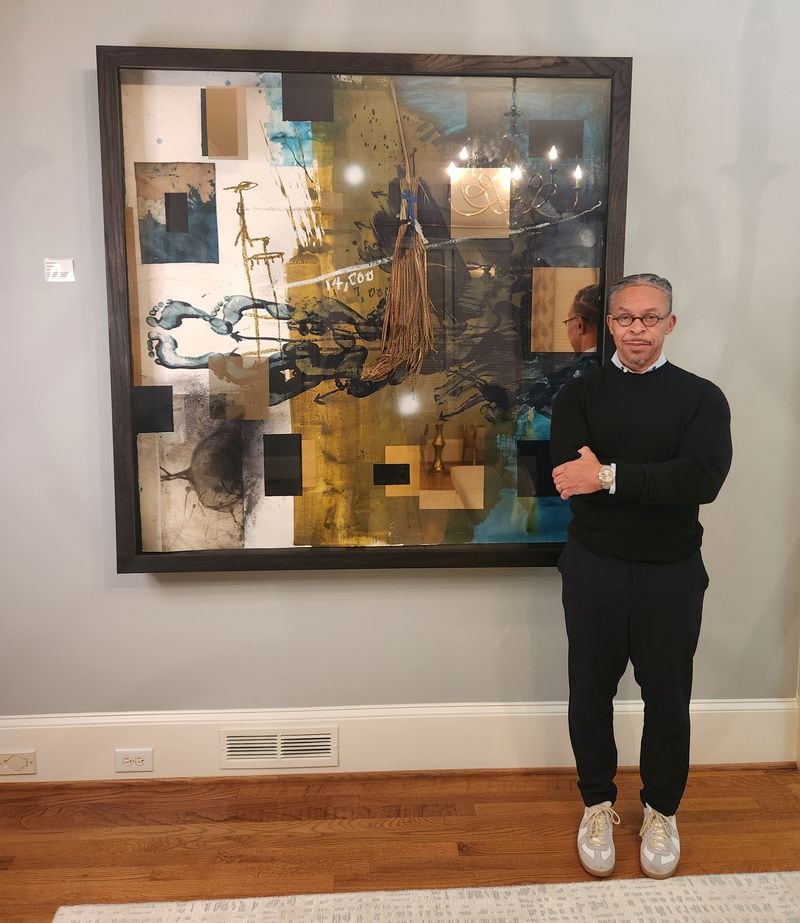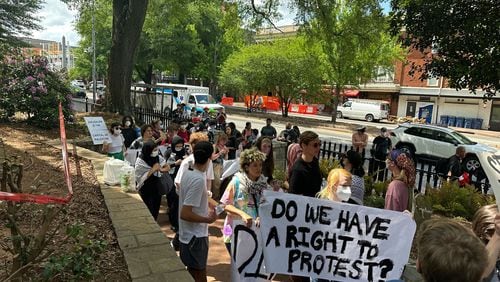For Esohe and George Galbreath the art that fills nearly every wall of their three-story Atlanta home is about more than aesthetics.
“We want to be good stewards of our story,” said Esohe Galbreath, who began seriously collecting in 2012, a year after she and George, an artist and high school art teacher, were married.
Today, the Galbreaths are part of a growing number Black collectors. Some collect work by Black artists as a way to conserve Black history and creativity, one painting, photograph, drawing and sculpture at a time.
By doing so they are also supporting artists, whose work has been ignored or underrepresented by museums and galleries for far too long.
“Black creativity is often not monetized and appreciated the way it should be,” said Esohe Galbreath, who has a background in engineering and accounting. “Recently Black artwork has become really big and if you don’t preserve your story somebody else will.”
In recent years, she said, collecting Black art is more popular and collectors are more open to talking about their collections.
The Galbreaths bought their first pieces - small contemporary abstract wall sculptures displayed in shadow boxes - from an Atlanta artist for $350.
Today, their 200-piece collection includes work by Atlanta artists Kevin Cole, Shaneqa Gay and Fahamu Pecou and ranges from $100 to an $18,000 sculpture.
They have specifically selected work by emerging and mid-career artists. They have prioritized their spending, focusing on travel and art. The $18,000 sculpture, for instance, was bought over the course of nearly a year, she said.
“We don’t have any artwork from artists we don’t know, have met or had some kind of conversation with” said Esohe Galbreath. “We think it’s important when you’re bringing energy into your house, that you know the person’s energy.”
To start collecting, said George Galbreath, one doesn’t have to spend big bucks on, say, well-known artists, such as Romare Bearden, Alma Thomas or Jean-Michel Basquiat.
And you don’t have to have the deep pockets of well-known collectors such as former NBA star Camelo Anthony; Tina Knowles, designer and mother of Beyonce and Solange; singer and musician Alicia Keys and husband, Swizz Beatz, a producer and rapper.
Knowles, has shared in interviews that she bought her first piece for $500 from a furniture store and now includes work by Bearden, John Biggers and sculptor Elizabeth Catlett.
People have several ways to find and buy art from art fairs, galleries, estate sales or buy art from local artists during your travels. Some collectors also buy online directly from the artist or photographer.
“One of the things we learned is that when you collect work from an entry-level artist of your same age range, there is an opportunity to grow a certain amount of equity before that artist’s work grows in value.” said George Galbreath
Halima Taha, the new artistic chair of the Atlanta Hammonds House Museum, curator, and author of “Collecting African American Art: Works on Paper and Canvas,” cautions people from following trends, and to only collect what you like and what resonates within.
“People who collect can be influenced by several factors: to decorate a home or office, for investment, as a social activity, and for the joy of the research journey. Perhaps it’s certain mediums, periods, or themes. Some people, for instance, only collect art by women artists or artists from the 1920s or 1960s.”
Others, she said, only like impressionist art, surreal or landscape paintings.
“It is essential to clarify your purpose and know that as you mature, the collection will mature and even change thematically.”
She said the “recent interest in collecting Black visual culture affirms that meritorious work produced by people of African descent is embraced for aesthetic and investment purposes by collectors worldwide. This is due to the increase in art fairs that attract people globally to the intellectual diversity of visual statements made by artists.”
“Not all Black people who collect art only collect work by African-American artists, Black people are not monolithic, nor are their collections, which often reflect the depth and expansive sum of their intellectual, emotional, and spiritual experiences,” she said. “I think that’s a big misnomer, rooted in colonial narratives that continue to cast a limited cloud over the perception of who Black people are and art not. Many Black people have an interest in collecting quality art, like any other serious art collector. And like other collectors, the interest includes every genre and aesthetic style. This is comparable to the way the range of tonal and chord progressions in music genres appeal to diverse sensibilities.”
Credit: Photo by Bert Bevans
Credit: Photo by Bert Bevans
As a child, Kent Kelley, a collector and a CFO in the software industry, watched his mother, Joycelyn Kelley, paint in her spare time.
“I grew up not only seeing her do that work but being able to see that work on the wall,” he said. “That whole experience of her as an artist gave me my initial appreciation of art.”
Kelley started collecting about two decades ago with a print by Charles Bibbs that he bought for $300 from a Black-owned gallery in Oakland. He started collecting on a larger scale in 2015.
When he started going to gallery shows he didn’t see the level of Black artists having exhibitions that he does now and he didn’t see the collector base either. “They were out there but you see a lot more now,” he said, in part because publicity about collectors and people having more disposable income.
He’s in a couple of chat groups with other Black collectors, one of which has 90 members.
Kelley is a member of the High Museum of Art’s board of trustees,
Credit: Contributed
Credit: Contributed
Kelley looks for a spiritual or emotional connection to a work before he adds it to his personal collection. “It has to be something I enjoy seeing on my wall every day. It’s work that will appreciate in value. I put myself in the shoes of a museum curator. If it meets those criteria, then it’s an easy decision when it comes to buying.”
Camille Love, executive director of the Mayor’s Office of Cultural Affairs, has witnessed the number of Black artists and collectors grow over the years. She has 60 works in her private collection.
Love’s collection strategy is to buy artwork that gives her a feeling of connection.
“They make me feel a certain way and I want them to be part of my living environment,” said Love, who owns about 60 pieces. “That then helps me translate that feeling to my home.”
Love, a former gallery owner, said her collection is largely by Black artists. She has seen more galleries and museums and white collectors include work of those artists as well.
There’s an acknowledgement that “Black art is American arts and those who have collections realized they didn’t have complete collections if they failed to include Black American artists.”
Black businesses such as Atlanta Life Insurance Company also had art collections in their headquarters, which also served to educate and expose more people to the beauty of art and collecting.
“The Cosby Show” also highlighted the beauty of Black artwork and collecting, she said. The popular show featured the upper middle class Huxtable family and scenes inside their home featured beautiful artwork by Black artists.
Ellis Wilson’s “Funeral Procession,” for instance, is a painting that went from relative obscurity to wide recognition after a replica was featured in an episode of the show.
Black businesses such as Atlanta Life Insurance Company also had art collections in their headquarters, which also served to educate and expose more people to the beauty of art and collecting.
Love said the practice of collecting art among African American was often in cities with Black universities such as Washington, D.C., Atlanta and Nashville but also in places like Los Angeles, Chicago and New York because they had artists who were very much part of the social scene.
“I think people are realizing the financial value of artwork, but also the emotional value of artwork,” she said. “It’s an awakening that’s happening now.”.
And buying artwork can mean a lot to the artist as well.
Years after buying one painting, the Galbreaths ran into the artist again. He told them that he had considered giving up art because he needed to earn money to pay bills.
The Galbreath’s purchase, at the time however, gave him the motivation to continue creating. It helped him buy supplies and pay bills.
“Collectors have a valuable role to play in the art eco-system,” he said. “We support artists so they can continue to create and share their work with the world.“
